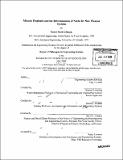| dc.contributor.advisor | Warren P. Seering. | en_US |
| dc.contributor.author | Gillespie, Daniel Mark | en_US |
| dc.contributor.other | Massachusetts Institute of Technology. Engineering Systems Division. | en_US |
| dc.date.accessioned | 2010-03-25T15:15:55Z | |
| dc.date.available | 2010-03-25T15:15:55Z | |
| dc.date.copyright | 2009 | en_US |
| dc.date.issued | 2009 | en_US |
| dc.identifier.uri | http://hdl.handle.net/1721.1/53215 | |
| dc.description | Thesis (Ph. D.)--Massachusetts Institute of Technology, Engineering Systems Division, 2009. | en_US |
| dc.description | Cataloged from PDF version of thesis. | en_US |
| dc.description | Includes bibliographical references. | en_US |
| dc.description.abstract | Efforts to understand the determination of needs of new weapon systems must take into account inputs and actions beyond the formally documented requirements generation process. This study analyzes three recent historical cases of fighter aircraft development to identify decisions made independently from the documented requirements process, about the need for new systems. The primary inputs to those decisions are identified, and a qualitative model for understanding the undocumented inputs, and their role in determining weapon system needs, is presented. By analyzing data across the cases, which span a period of significant change in fighter design, the concept of a Dominant Mission Emphasis (DME) is introduced. The DME is defined as that mission which receives the most emphasis from the majority of participants in the needs determination process, and which the majority of other missions support, either directly or indirectly. It emerges when enough participants become convinced that it is appropriate to address the military, economic, political, social, and other needs that exist, and it serves as a means for bounding the intractable array of possibilities for weapon system needs. The convincing of participants occurs primarily through a social process, not a technical or an authoritative one. Over time, as conditions change, the appropriateness of the DME will decrease. The appropriateness over time can be modeled with a bell-shaped curve. Cues are identified which suggest the need to re-examine the DME. | en_US |
| dc.description.abstract | (cont.) The strength of a DME can be measured by qualitative and quantitative indicators, including such things as verbal statements, military doctrine, intellectual and academic writings, organization within the military, resources committed, and promotion decisions. These indicators can also be used as controls to strengthen or weaken a DME in response to the perception of its appropriateness for existing conditions. The DME is constantly being questioned and challenged by individuals who seek to convince others that its appropriateness is not sufficient for existing conditions. Alternative missions are proposed and advocated as new DMEs. The roles of the primary means for convincing participants of the appropriateness of a DME are presented. | en_US |
| dc.description.statementofresponsibility | by Daniel Mark Gillespie. | en_US |
| dc.format.extent | 428 p. | en_US |
| dc.language.iso | eng | en_US |
| dc.publisher | Massachusetts Institute of Technology | en_US |
| dc.rights | M.I.T. theses are protected by
copyright. They may be viewed from this source for any purpose, but
reproduction or distribution in any format is prohibited without written
permission. See provided URL for inquiries about permission. | en_US |
| dc.rights.uri | http://dspace.mit.edu/handle/1721.1/7582 | en_US |
| dc.subject | Engineering Systems Division. | en_US |
| dc.title | Mission emphasis and the determination of needs for new weapon systems | en_US |
| dc.type | Thesis | en_US |
| dc.description.degree | Ph.D. | en_US |
| dc.contributor.department | Massachusetts Institute of Technology. Engineering Systems Division | |
| dc.identifier.oclc | 528816125 | en_US |
